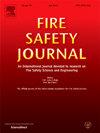Evaluating backdraft phenomenon generated from a wood fuel through a holistic approach
IF 3.4
3区 工程技术
Q2 ENGINEERING, CIVIL
引用次数: 0
Abstract
This work examines backdraft phenomenon generated from a wood fuel assembled into a crib structure. Twenty-six backdraft experiments were conducted in a reduced-scale enclosure to determine components that influence the ignition and deflagration required for backdraft phenomenon. A wide range of heat release rates before the enclosure’s isolation time was implemented in the experimental campaign, spanning from 88 kW 8 kW to 216 kW 19 kW. The duration of the isolation time, at which the compartment remains closed before an anticipated backdraft event, was also modified between 120 s, 210 s, and 300 s to determine their effect on critical parameters. To account for the complexity of the produced pyrolyzate, a second-generation phi meter was utilized to measure equivalence ratios in the upper and lower regions of the compartment. Temperature and oxygen, carbon dioxide, and carbon monoxide concentration measurements were also obtained at various locations within the reduced-scale enclosure. Time-averaged temperature and oxygen concentration measurements were compared to similar measurements in other works, highlighting limitations in identifying universal conditions conducive to backdraft. Time-averaged equivalence ratio measurements greater than 5 in the upper region of the enclosure were found to signify the occurrence of backdraft, suggesting that its likelihood is associated with the distribution of vapor fuel and oxygen. A logistic regression model was implemented to examine how parameter differences in the compartment’s upper and lower regions contribute to backdraft occurrence. A probability threshold for the backdraft phenomenon between the temperature and vapor fuel ratios in the upper and lower regions of the compartment is established. Spatial ratios of temperature and vapor fuel fraction are compared against each other using the logistic regression model to comment on the incoming flow of the gravity current and residing fuel concentration within the compartment prior to an anticipated backdraft event. A further evaluation of the probability threshold using the backdraft ignition time suggests that the distribution of temperature and fuel affects the gravity current velocity, mixing time, and eventual combustion of incoming air.
通过整体方法评估木材燃料产生的回风现象
这项工作考察了由木质燃料组装成婴儿床结构产生的回风现象。在缩小尺寸的封闭环境中进行了26次回风实验,以确定影响回风现象所需的点火和爆燃的因素。在实验活动中,在外壳隔离时间之前实施了广泛的热释放率,范围从88 kW±8 kW到216 kW±19 kW。隔离时间的持续时间也在120秒、210秒和300秒之间进行了修改,以确定它们对关键参数的影响。隔离时间在预期的回流事件发生之前,舱室保持关闭状态。考虑到产生的热解产物的复杂性,使用第二代phi计来测量隔室上部和下部区域的等效比。温度和氧气、二氧化碳和一氧化碳浓度的测量也在缩小尺寸的外壳内的不同位置获得。将时间平均温度和氧浓度测量值与其他工作中的类似测量值进行了比较,突出了在确定有利于回流的普遍条件方面的局限性。时间平均等效比测量值在外壳上部区域大于5,表明发生回气流,表明其可能性与蒸汽燃料和氧气的分布有关。采用逻辑回归模型来检验车厢上部和下部区域的参数差异如何导致回风的发生。建立了舱室上下区域温度比和蒸汽燃料比之间的回风现象的概率阈值。使用逻辑回归模型相互比较温度和蒸汽燃料分数的空间比率,以评论在预期的回流事件之前重力流的流入和驻留在舱内的燃料浓度。利用回风点火时间对概率阈值的进一步评估表明,温度和燃料的分布影响重力流速度、混合时间和进入空气的最终燃烧。
本文章由计算机程序翻译,如有差异,请以英文原文为准。
求助全文
约1分钟内获得全文
求助全文
来源期刊

Fire Safety Journal
工程技术-材料科学:综合
CiteScore
5.70
自引率
9.70%
发文量
153
审稿时长
60 days
期刊介绍:
Fire Safety Journal is the leading publication dealing with all aspects of fire safety engineering. Its scope is purposefully wide, as it is deemed important to encourage papers from all sources within this multidisciplinary subject, thus providing a forum for its further development as a distinct engineering discipline. This is an essential step towards gaining a status equal to that enjoyed by the other engineering disciplines.
 求助内容:
求助内容: 应助结果提醒方式:
应助结果提醒方式:


